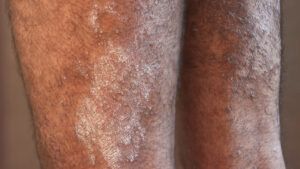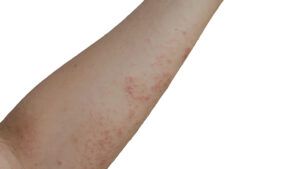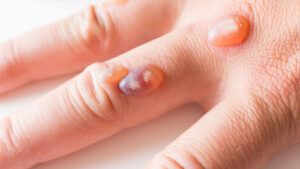In its early stages, kidney disease may not cause any symptoms or signs. However, as it progresses, it can cause symptoms such as itchy skin, pruritus, and a rash.
Around 35.5 million adults in the United States live with kidney disease, but only about 10% know they have it. This is because the early stages of kidney disease do not typically cause symptoms.
As the disease progresses, it can cause general symptoms, including fatigue, frequent urination, and itchy skin. Because many of these symptoms are not specific to kidney disease, a person may only find out they have it through testing.
This article reviews itchy skin as a symptom of kidney disease, its causes, symptoms, and more.

Kidney disease can cause dry, irritated, and itchy skin, or “pruritus.” Healthcare professionals refer to itchy skin that results from chronic kidney disease as chronic kidney disease-associated pruritus (CKD-aP).
People with CKD-aP can also experience a rash, dry skin, or skin lesions due to scratching.
Some experts may refer to this condition as uremic pruritus because of the buildup of toxic materials and chemicals that the kidneys typically filter out of a person’s blood. If kidney disease has damaged the kidneys, they cannot filter blood as usual.
Like other symptoms, itchy skin and rashes may not appear in the early stages of kidney disease. Instead, they may appear when the minerals in the blood become unbalanced due to the kidney’s diminished filtering capabilities.
According to a
The exact cause of CKD-aP is not clear, but theories suggest that it may involve any of the following factors:
- immune system response
- a lack of balance in signals sent to opioid receptors in nerve cells
- hyperparathyroidism — high parathyroid hormone (PTH) levels in the blood
- the release of histamine and other chemicals from cells, which can cause itching
- insufficient dialysis that does not properly remove toxins and wastes
- nerve damage
- high aluminum or magnesium levels in the blood
- high combined levels of calcium and phosphorus in the blood
- shrinkage of sweat glands, which can lead to dry skin
Pruritis symptoms can last for
Itchy skin symptoms
Up to half of people experience itchiness on their entire body. Alternatively, it may affect only a certain part of the body, such as the face, back, or arm.
Itchy skin due to kidney disease often:
- worsens at night
- improves with activity
- worsens due to heat, stress, or other factors
- fluctuates during hemodialysis sessions
- improves with hot or cold showers or in cool temperatures
The extremely itchy skin can also cause a person to experience:
- reduced self-esteem
- changes in mood
- depression
- changes in personal relationships
- worsening sleep
- infections due to continual scratching, which may lead to hospitalization or death
Rash symptoms
People with chronic kidney disease may not experience any skin symptoms, or they may have a rash, dry patches, and blisters. They may also develop skin lesions due to scratching itchy skin.
According to the American Academy of Dermatology (AAD), people with chronic kidney disease may have:
- small, dome-shaped, very itchy bumps
- small bumps that have joined to form raised, rough patches
- blisters on the hands, face, and feet that may crust over
- extremely dry skin that may feel tight and look scaly or cracked
- skin lesions, scratch marks, or thickened, dry skin from excessive scratching
Anyone can develop skin lesions as a result of scratching their skin repeatedly, so appropriate treatment is helpful for preventing further damage to the skin.
People often do not receive a diagnosis for itchy skin in any stage of kidney disease. This may be partly due to differences in symptoms from person to person.
A healthcare professional may try to confirm the diagnosis with a skin exam or a review of dialysis numbers or by trying different topical treatments.
Unless another underlying cause is present, healthcare professionals may consider any itchy skin in a person with kidney disease to be pruritis.
If a person is experiencing even infrequent itchiness, it is important that they report their symptoms to a healthcare professional so they can receive a diagnosis and begin treatment.
Learn more about potential signs of kidney damage.
Treatment may include both systemic medications, which work throughout the body, and topical products, which a person can apply directly to the affected area.
People on dialysis will likely benefit from treatments that help with high PTH, phosphorus, and magnesium levels in their blood.
This may involve:
- certain medications
- changes in dialysis prescription
- increases in dialysis treatment times
- a change in the type of dialysis filter
Healthcare professionals will typically start treatment with topical creams and ointments to help relieve itching. People may use emollients that moisten and soften the skin and analgesics that alleviate itching and reduce pain.
If a person does not respond well to topical treatments, a healthcare professional may recommend:
- antihistamines
- medication for nerve pain, such as gabapentin or pregabalin
- ultraviolet B (UVB) phototherapy
- difelikefalin — a drug that improves the imbalance of nerve signals that leads to itching — for people on dialysis
Experimental treatments include the use of omega-3 and omega-6 fatty acids. However, more research is necessary into their effectiveness for itchy skin in chronic kidney disease.
Here are some answers to frequently asked questions about kidney disease.
At what stage of kidney disease does itching occur?
A person’s skin may itch at any stage of kidney disease, but itching is most common in advanced stages or during kidney failure.
What are the three early warning signs of kidney disease?
Early warning signs can differ from person to person but may include:
Symptoms often do not show until the later stages of kidney disease. If a person experiences one or more of these symptoms, they should consult a healthcare professional as soon as possible.
Kidney disease can lead to itchy skin or a rash. This can occur at any stage of the disease, but it is most common in more advanced stages.
When it occurs, it may appear all over the body or in only certain areas. Some people will not see any signs of skin rash, such as raised bumps, spots, or blisters, while others may. Chronic and frequent scratching can lead to lesions and other sores on the skin.
Treatment typically involves a combination of topical creams and systemic medications.









